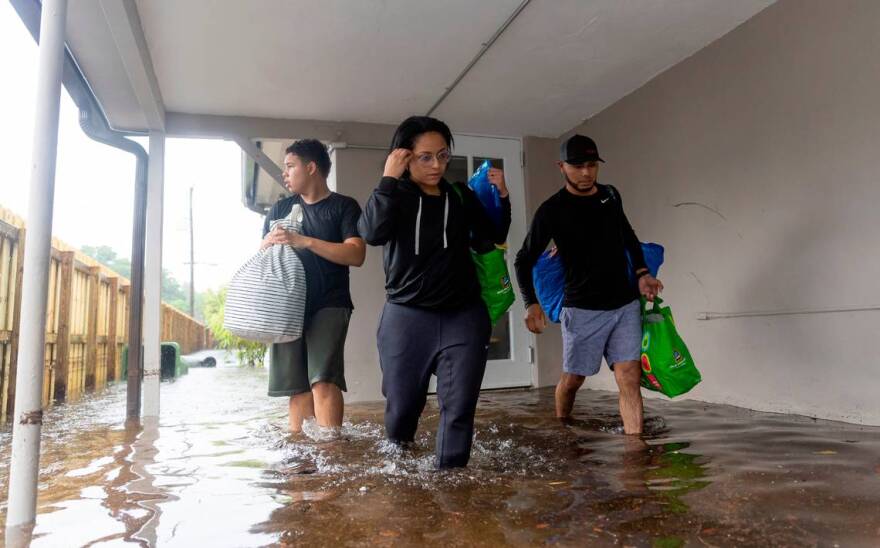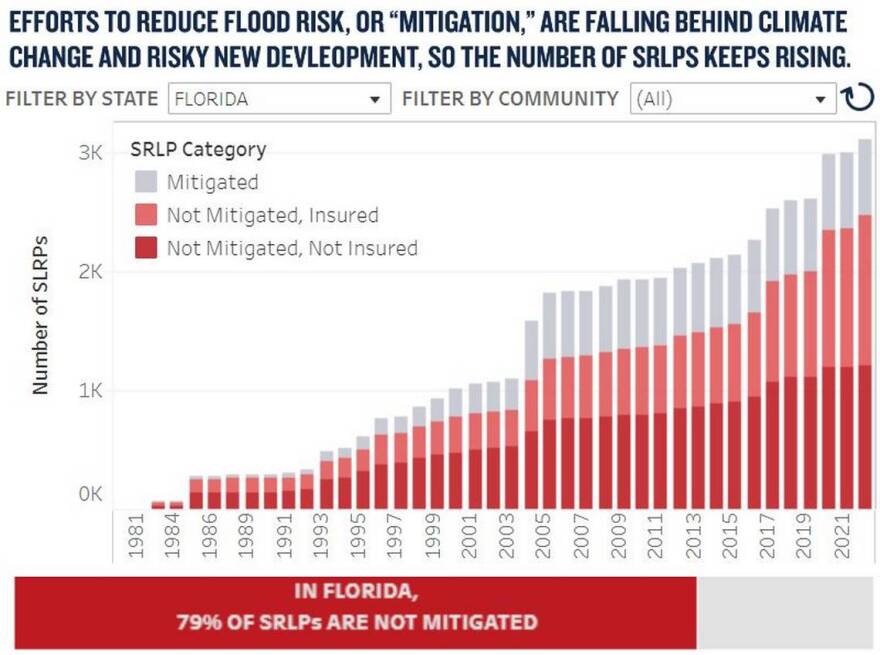Between “rain bombs” and drenching from no-name storms, hundreds of homes in South Florida have experienced damaging flooding in the last year alone. But an exact count of flood-prone homes in South Florida — and where and how often they flood — has been all but impossible to pin down.
Newly released data from the Federal Emergency Management Agency puts some hard numbers to a problem that climate change promises to make worse in the coming decades. Thousands of homes across the state have endured water damage more than once. It’s a number that is growing across the state, in part because in the vast majority of cases, little has been done to protect the properties from future floods.
Here’s the kicker: Potential buyers and renters are prohibited from knowing that flooding history under federal and state rules. And those FEMA numbers are almost assuredly an undercount of flood-prone properties because the agency’s data reflects only insured properties that filed flood claims with the National Flood Insurance Program. Plenty of homeowners are not required to hold flood insurance policies or use a private company that doesn’t report claims data.
“These are the tip of the iceberg when it comes to repeatedly flooded properties in the US,” said Anna Weber, a senior policy analyst at the Natural Resources Defense Council, which analyzed the FEMA data.
The FEMA data in question, released by the NRCD on Tuesday, is just part of the flood damage picture, showing only what the federal government declares as a “severe repetitive loss property.” That designation covers homes that have flooded twice, with damage totaling the value of the property, or flooded four times with at least $5,000 of damage each time.

There are about 45,000 of these properties in the U.S., as of the end of 2022, with about 3,100 in Florida alone, according to FEMA data analyzed by the NRDC. Florida added about 120 of those homes from 2021 to 2022.
But Floridians don’t get to know where, exactly, these homes are, due to federal and state laws that block renters or home buyers from learning about past flooding on private properties. Two new bills filed this year could address it, but previous attempts to solve the problem in Tallahassee have failed.
Weber said that some of the Florida list have flooded more than 9 times in the last decade alone.
Because the FEMA numbers run only through the end of 2022, they don’t show repetitive loss figures from the historic rainfall that drowned some low-lying Fort Lauderdale neighborhoods last April. FEMA shows only 23 insured homes in the city that have experienced repeated flooding. That number could soar in next year’s data as the city counted more than 1,100 homes flooded after the “rain bomb.” Many residents in neighborhoods like River Oaks reported that it wasn’t the first time they’d had damage.
According to the NRDC analysis of FEMA’s data, the vast majority of the state’s problem properties remain highly vulnerable. Of the 3,100, only a hundred have been fixed in the last few decades, either by elevating the house high enough that it doesn’t flood, or buying the property, razing the house and turning the empty lot into a grassy lot that absorbs water.
That’s what North Miami did with one of its repetitive loss properties in 2019, which is now a mini park designed to absorb the neighborhood’s floodwater on rainy days.

But the rest of those 3,000 or so properties remain unfixed. About half were uninsured, as of 2022. The other half pay annual flood insurance premiums, but because the properties are classified as repetitive loss, they’re charged far higher annual prices than their neighbors
“The pace at which we are adding properties to the severe repetitive loss list far outstrips the pace at which we are mitigating them,” Weber said. “If we’re failing to keep up with mitigating these most vulnerable properties, that’s not a good sign for all the other properties with flood risk around the country.”
FLOOD HISTORY IS A SECRET IN FLORIDA
In Miami-Dade alone, there are about 280 official repetitive loss properties. Broward has about 119, and Manatee County has about 100 Despite its small population, Monroe County, which includes the Florida Keys, has at least 173 homes.
The two counties with the highest count were Santa Rosa, with more than 460, and Pinellas, with just over 600.
But their locations are a secret, including, sometimes, to the people who own them.
That’s because FEMA decided that sharing the addresses of these properties with the public would be a violation of federal privacy laws. Only the federal government, and local planning officials, get to see the exact location of these flood-troubled properties.
That’s helpful to sellers looking to offload a flood-prone house, but less so for home buyers hoping to avoid purchasing a home that moonlights as a swimming pool.

Weber said that FEMA’s policy is to only share past flood history with a property owner that holds an active flood insurance policy on a property, so prospective buyers may only know the details of their property’s flood history after they’ve closed the deal.
“We’ve heard anecdotally that this happens with distressing frequently,” she said. “There’s really no way for a home buyer to just Google the address of a property and see what its flood insurance claim history is.”
Some states, like Virginia, require sellers to disclose if a property is a repetitive loss. Others, like Texas, go above and beyond and require both home sellers and landlords to inform tenants about past flood issues.
READ MORE: Has your house or apartment flooded before? In Florida, good luck finding out
But Florida doesn’t require any specific flood disclosures. Bills to address this have failed repeatedly in recent years, and the state’s real estate industry points to a voluntary flood disclosure form that buyers can choose to fill out. If they lie on the form or fail to disclose something major that affects the property’s value — like a history of severe flooding — the buyer could sue.
That was exactly what happened with a Palm Beach County woman in 2019. She won the lawsuit, but didn’t collect much of her winnings in the end.
That’s why some advocates, like NRDC, are pushing for mandatory flood disclosure at the national level. The Biden administration is considering it, but it could be years before anything is enacted.
Two new bills were introduced in Tallahassee this week to potentially correct the issue: Senate Bill 484 by Jennifer Bradley (R - Fleming Island) and Senate Bill 38 by Linda Stewart (D - Orlando).
Stewart’s bill would require landlords to inform tenants if they’re in a flood zone, and Bradley’s bill would require home sellers to disclose past flooding, as well as flood insurance claims, on their property to potential buyers.
This story was produced in partnership with the Florida Climate Reporting Network, a multi-newsroom initiative founded by the Miami Herald, the South Florida Sun Sentinel, The Palm Beach Post, the Orlando Sentinel, WLRN Public Media and the Tampa Bay Times.





